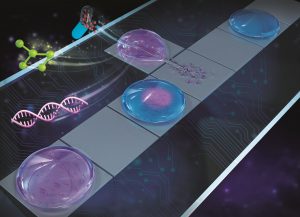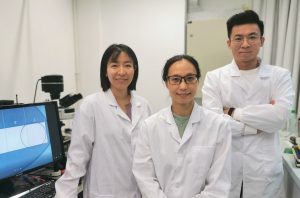A research team in the University of Macau’s (UM) Institute of Microelectronics has developed a new on-chip sample delivery technology. The new technology will not only enhance droplet dispensing on chips, but will also greatly improve sample preparation efficiency, paving the way for realising ‘lab-on-a-chip’. The study has been published in the internationally well-known journal Lab on a Chip as a cover story.
Microfluidic technology, known as ‘lab-on-a-chip’, has long been considered to have great potential in biomedical research because of its advantages of miniaturisation, integration, and low consumption. However, after decades of development, this technology still has not been widely used in daily scientific workflow. One critical reason for biochemists’ reluctance to accept microfluidics is its complicated sample preparation on-chip, which is completely different from the traditional training for off-chip experiments with micropipettes. In this research project, a special electrode structure was designed on a digital microfluidic chip to eject ‘satellite droplets’ in a specific region to be picked up by another drop to realise on-chip sample delivery. With simple external electric signal control, the sample can be conveniently and flexibly delivered within a large range (5pL~20nL). It is extremely close to the delivery method of traditional pipettes while avoiding complicated and tedious operating procedures.
According to the research team, this technology provides researchers with an easy and flexible way to dispense droplets on a chip, bridging the gap between traditional experimental platforms and microfluidic technology, which will help to truly realise ‘lab-on-a-chip’. At the same time, it provides a powerful tool for achieving a high-throughput portable platform. Combined with the team’s experience and achievements in such fields as nucleic acid detection and drug screening, this technology is expected to be used in the development of portable biochemical experimental analysis equipment, which will help realise the transformation of research results and contribute to scientific and technological innovation in the Greater Bay Area.
Assistant Professor Jia Yanwei in the Institute of Microelectronics is the corresponding author of the article. PhD student Li Haoran is the first author. PhD student Shen Ren, Prof Mak Pui In, and Prof Rui Martins also made important contributions to this study. This project was funded by the Science and Technology Development Fund, Macao SAR (file no: 0053/2019/A1, 110/2016/A3 and SKL-AMSV(UM)-2020-2022) and UM (file no: MYRG2017-00022-AMSV and MYRG2018-00114-AMSV). To read the related research article titled ‘Turn On/Off Satellite Droplet Ejection for Flexible Sample Delivery on Digital Microfluidic Systems’, please visit
https://pubs.rsc.org/en/content/articlelanding/2020/lc/d0lc00701c#!divAbstract
Source: State Key Laboratory of Analog and Mixed-Signal VLSI at University of Macau
Media Contact Information:Communications Office, University of Macau
Albee Lei Tel:(853) 88228004Judite Lam Tel:(853) 88228022Email:prs.media@um.edu.mo
UM Website:www.um.edu.mo


